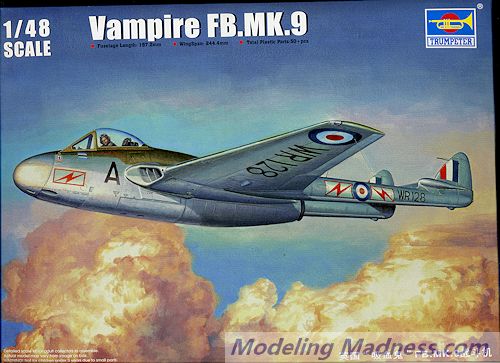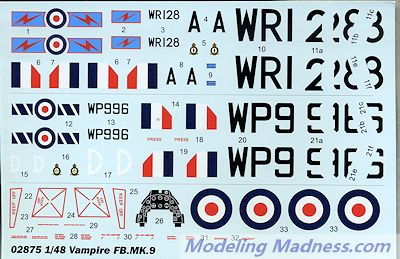
| KIT #: | 02875 |
| PRICE: | $31.95 SRP |
| DECALS: | Two options |
| REVIEWER: | Scott Van Aken |
| NOTES: | New tool kit |

| HISTORY |
The de Havilland DH.100 Vampire was a British jet fighter commissioned by the Royal Air Force during the Second World War. Following the Gloster Meteor, it was the second jet fighter to enter service with the RAF. Although it arrived too late to see combat during the war, the Vampire served with front line RAF squadrons until 1953 and continued in use as a trainer until 1966, although generally the RAF relegated the Vampire to advanced training roles in the mid-1950s and the type was generally out of RAF service by the end of the decade. The Vampire also served with many air forces worldwide, setting aviation firsts and records.
Almost 3,300 Vampires were built, a quarter of them under licence in other countries. The Vampire design was also developed into the de Havilland Venom fighter-bomber as well as naval Sea Vampire variants.
FB.9: tropicalised fighter-bomber through addition of air conditioning to Mark 5. Powered by Goblin 3 turbojet; 326 built, mostly by de Havilland, but also by Fairey Aviation.
| THE KIT |
 Nice
to see a mainstream injected kit of this aircraft in this scale that has modern
tooling and gets the shapes right. At least it looks like it got them right.
Prior to this we had the Hobbycraft kit which had some major shape issues and
the short run Classic Airframes version, which required quite a few modeling
skills to get together without screaming and yelling!
Nice
to see a mainstream injected kit of this aircraft in this scale that has modern
tooling and gets the shapes right. At least it looks like it got them right.
Prior to this we had the Hobbycraft kit which had some major shape issues and
the short run Classic Airframes version, which required quite a few modeling
skills to get together without screaming and yelling!
Typical of modern Trumpeter kits, this one is superbly molded. It has a nicely detailed cockpit that only needs a harness to look proper. A decal is provided for the instrument panel though you could easily gussy up the plastic one with paint and drybrushing. interior side panels are also included. Like most Vampire kits, the interior and the nose gear well are intricately intertwined with the latter having very nicely done gear bracing for the strut. The strut appears to be properly extended as the Vampire usually sat tail low.
The upper and lower fuselage incorporate the wings, making assembly quite easy. One simply installed the main gear wells, the nose gear well, cockpit and tailpipe before closing the halves. Quite a bit of weight will be needed to prevent tail sitting so it is a good idea to tape the main components together, including the tail section to determine how much will be needed. Tail booms are like on just about every other Vampire kit and are two vertical halves that get attached to stubs at the end of the wing. The instructions would have to assemble the booms and horizontal stabilizer before attaching them to the wing/fuselage assembly.
The landing gear is nicely formed and the inside of the gear wells and doors has acceptable detail. The engine intakes are separate pieces that fit in once the fuselage is completely together. These include the little vanes in the inside of the intakes. No intake trunking with this one. There is a two piece clear assembly consisting of the windscreen and separate canopy. You have your choice of drop tanks with those on pylons and conformal tanks for under the wing. Unfortunately, Trumpeter has decided that you WILL use the tanks and has already drilled holes in the lower wing for them. I wish they would let the builder decide.
 The bad part
is that this is not an FB.9. Yep, the FB.9 had an air conditioning package that
fit just in front of the right intake and this piece is completely missing from
the kit. It will build into an FB.5 or FB.4, but you'll have to rely on
aftermarket to build it as an FB.9. That being said, the serials included in the
kits are both for FB.9s and so that means you will have to do some research to
see if either of the two units (which are not identified) ever flew the earlier
ones and make the proper serial number adjustments to match. I am sure there are
or will be aftermarket Vampire sheets out to help in this regard. The box art
plane is in the camouflage scheme and these will be gloss. The other options is
for one in high speed silver with red fin/rudder/bullets.
The bad part
is that this is not an FB.9. Yep, the FB.9 had an air conditioning package that
fit just in front of the right intake and this piece is completely missing from
the kit. It will build into an FB.5 or FB.4, but you'll have to rely on
aftermarket to build it as an FB.9. That being said, the serials included in the
kits are both for FB.9s and so that means you will have to do some research to
see if either of the two units (which are not identified) ever flew the earlier
ones and make the proper serial number adjustments to match. I am sure there are
or will be aftermarket Vampire sheets out to help in this regard. The box art
plane is in the camouflage scheme and these will be gloss. The other options is
for one in high speed silver with red fin/rudder/bullets.
| CONCLUSIONS |
So we now have a nice looking Vampire with the usual major glitch that seems to dog Chinese kit makers. In this case, it is not impossible to work around, it just means you cannot use the kit decals as they are.
| REFERENCES |
http://en.wikipedia.org/wiki/De_Havilland_Vampire
March 2013
Thanks to me for picking this one up at the LHS.
If you would like your product reviewed fairly and fairly quickly, please contact the editor or see other details in the Note to Contributors.